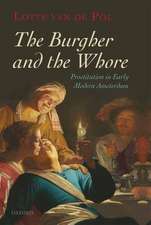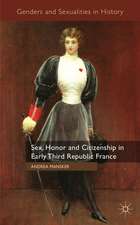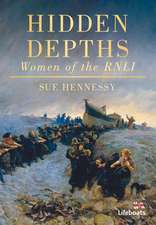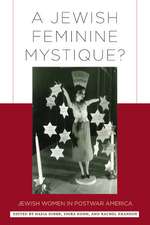Women, Identities and Communities in Early Modern Europe: Women and Gender in the Early Modern World
Editat de Stephanie Tarbin, Susan Broomhallen Limba Engleză Hardback – 20 mai 2008
Din seria Women and Gender in the Early Modern World
- 9%
 Preț: 1003.31 lei
Preț: 1003.31 lei -
 Preț: 289.10 lei
Preț: 289.10 lei - 19%
 Preț: 364.64 lei
Preț: 364.64 lei - 8%
 Preț: 383.57 lei
Preț: 383.57 lei - 9%
 Preț: 936.16 lei
Preț: 936.16 lei -
 Preț: 223.84 lei
Preț: 223.84 lei - 9%
 Preț: 934.94 lei
Preț: 934.94 lei - 18%
 Preț: 1054.71 lei
Preț: 1054.71 lei - 18%
 Preț: 1000.27 lei
Preț: 1000.27 lei - 18%
 Preț: 1054.71 lei
Preț: 1054.71 lei - 18%
 Preț: 1055.06 lei
Preț: 1055.06 lei - 18%
 Preț: 1000.27 lei
Preț: 1000.27 lei - 25%
 Preț: 497.08 lei
Preț: 497.08 lei - 18%
 Preț: 1000.27 lei
Preț: 1000.27 lei -
 Preț: 369.73 lei
Preț: 369.73 lei - 18%
 Preț: 1056.63 lei
Preț: 1056.63 lei - 25%
 Preț: 826.01 lei
Preț: 826.01 lei - 25%
 Preț: 768.30 lei
Preț: 768.30 lei - 18%
 Preț: 1053.92 lei
Preț: 1053.92 lei - 26%
 Preț: 764.20 lei
Preț: 764.20 lei - 26%
 Preț: 764.20 lei
Preț: 764.20 lei - 18%
 Preț: 1001.84 lei
Preț: 1001.84 lei - 26%
 Preț: 819.48 lei
Preț: 819.48 lei - 18%
 Preț: 1113.63 lei
Preț: 1113.63 lei - 16%
 Preț: 234.90 lei
Preț: 234.90 lei - 18%
 Preț: 1061.81 lei
Preț: 1061.81 lei - 25%
 Preț: 766.85 lei
Preț: 766.85 lei - 18%
 Preț: 1060.25 lei
Preț: 1060.25 lei - 26%
 Preț: 734.75 lei
Preț: 734.75 lei - 18%
 Preț: 1061.81 lei
Preț: 1061.81 lei - 25%
 Preț: 767.07 lei
Preț: 767.07 lei - 25%
 Preț: 769.92 lei
Preț: 769.92 lei - 18%
 Preț: 1058.69 lei
Preț: 1058.69 lei - 18%
 Preț: 1061.06 lei
Preț: 1061.06 lei - 26%
 Preț: 878.57 lei
Preț: 878.57 lei - 18%
 Preț: 1064.70 lei
Preț: 1064.70 lei - 18%
 Preț: 1107.61 lei
Preț: 1107.61 lei - 26%
 Preț: 736.38 lei
Preț: 736.38 lei - 18%
 Preț: 1068.15 lei
Preț: 1068.15 lei - 18%
 Preț: 1061.06 lei
Preț: 1061.06 lei - 18%
 Preț: 1000.76 lei
Preț: 1000.76 lei - 26%
 Preț: 819.84 lei
Preț: 819.84 lei - 18%
 Preț: 1109.18 lei
Preț: 1109.18 lei - 26%
 Preț: 821.53 lei
Preț: 821.53 lei - 18%
 Preț: 1000.27 lei
Preț: 1000.27 lei - 25%
 Preț: 827.76 lei
Preț: 827.76 lei
Preț: 369.73 lei
Nou
Puncte Express: 555
Preț estimativ în valută:
70.76€ • 73.10$ • 58.89£
70.76€ • 73.10$ • 58.89£
Carte tipărită la comandă
Livrare economică 26 martie-09 aprilie
Preluare comenzi: 021 569.72.76
Specificații
ISBN-13: 9780754661849
ISBN-10: 0754661849
Pagini: 260
Dimensiuni: 156 x 234 x 16 mm
Greutate: 0.45 kg
Ediția:New.
Editura: Taylor & Francis
Colecția Routledge
Seria Women and Gender in the Early Modern World
Locul publicării:Oxford, United Kingdom
ISBN-10: 0754661849
Pagini: 260
Dimensiuni: 156 x 234 x 16 mm
Greutate: 0.45 kg
Ediția:New.
Editura: Taylor & Francis
Colecția Routledge
Seria Women and Gender in the Early Modern World
Locul publicării:Oxford, United Kingdom
Cuprins
Contents: Preface; Introduction, Stephanie Tarbin and Susan Broomhall; Part 1 Reading Communities in History: Real and imagined communities in the lives of women in 17th-century Ireland: identity and gender, Anne Laurence; The abuse of history? Identity politics, disordered identity and the 'really real' in French cases of demonic possession, Sarah Ferber. Part 2 Domestic Polities: 'In myn own house': the troubled connections between servant marriages, late-medieval English household communities, and early modern historiography, Philippa Maddern; Recusants, daughters, and sisters in Christ: English nuns and their communities in the 17th century, Claire Walker. Part 3 Social Networks: 'Charity is worth it when it looks that good': rural women and bequests of clothing in early modern England, Dolly MacKinnon; Female magic and women's social relations in 18th-century Sweden, Jacqueline van Gent. Part 4 Negotiating the City: The gorgon of Augsburg, Lyndal Roper; Giving birth at the magistrate's gate: single mothers in the early modern city, Laura Gowing. Part 5 Gentry communities: Neighbourhood as female community in the life of Anne Dormer, Sara Mendelson; A revolution correspondence: Elizabeth Packer Geddes and Elizabeth Burnet, Frances Harris. Part 6 Queens and Court: Gendering the culture of honour at the 15th-century Burgundian court, Susan Broomhall; Public identity and public memory: case studies of 2 Tudor women, Judith M. Richards; In praise of queens: the public presentation of the virtuous consort in 17th-centry Britain, Sybil Jack; Select bibliography; Index.
Recenzii
'The authors examine moments of shared gender identity as well as recognize the differences between women; and they analyze how notions of community could both result in solidarity as well as exclusions and divisions between women ... impressive in pulling together new and exciting work on a variety of topics, such as the meaning of neighborhood for women of the gentry class and the role of elite women as preservers and creators of courtly ritual ... makes an original contribution by arguing how community and identity constitute power relationships.' Amy Froide, University of Maryland, Baltimore County, author of Never Married: Singlewomen in Early Modern England
’The Introduction is strongly footnoted, with a number of relevant sources. The collection is well-edited, including a good, and up-to-date, select bibliography on the themes of the volume. The notes are thorough and there is also an index. This is a fine example of current work in feminist Early Modern scholarship. I strongly recommend it to students and specialists alike.’ Parergon
’The volume is a valuable addition to our knowledge of women's lives and self-perceptions in the early modern period and also has much that will be useful and thought-provoking to readers pursuing questions about how gender structured women's experiences of identity and community in other times and places as well.’ Sixteenth Century Journal
’The Introduction is strongly footnoted, with a number of relevant sources. The collection is well-edited, including a good, and up-to-date, select bibliography on the themes of the volume. The notes are thorough and there is also an index. This is a fine example of current work in feminist Early Modern scholarship. I strongly recommend it to students and specialists alike.’ Parergon
’The volume is a valuable addition to our knowledge of women's lives and self-perceptions in the early modern period and also has much that will be useful and thought-provoking to readers pursuing questions about how gender structured women's experiences of identity and community in other times and places as well.’ Sixteenth Century Journal
Notă biografică
Stephanie Tarbin is Research Fellow and Susan Broomhall is Associate Professor both in the School of Humanities at The University of Western Australia.
Descriere
Exploring the contradictory forces shaping women's identities and experiences, this collection examines the possibilities for commonalities and the forces of division between women in early modern Europe. The contributors analyse the critical power of gender to structure identities and experiences, adding new depth to our understanding of early modern women's senses of exclusion and belonging.
















